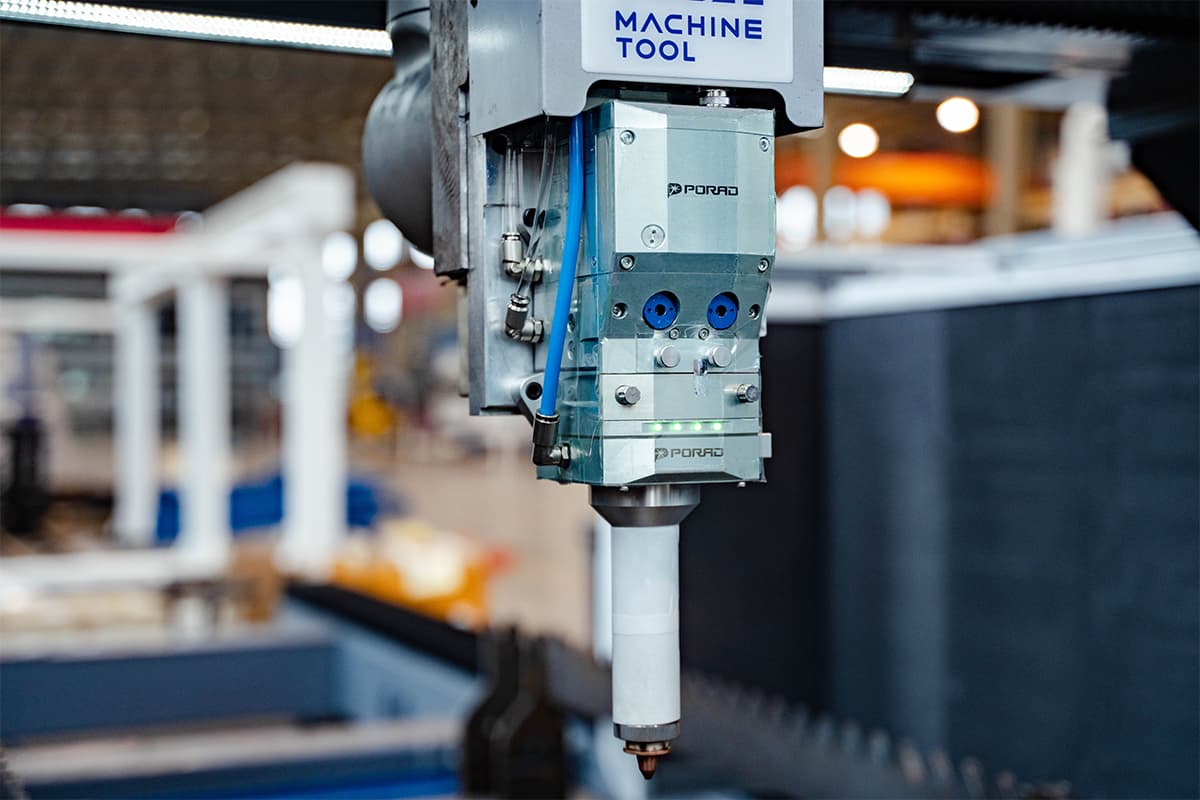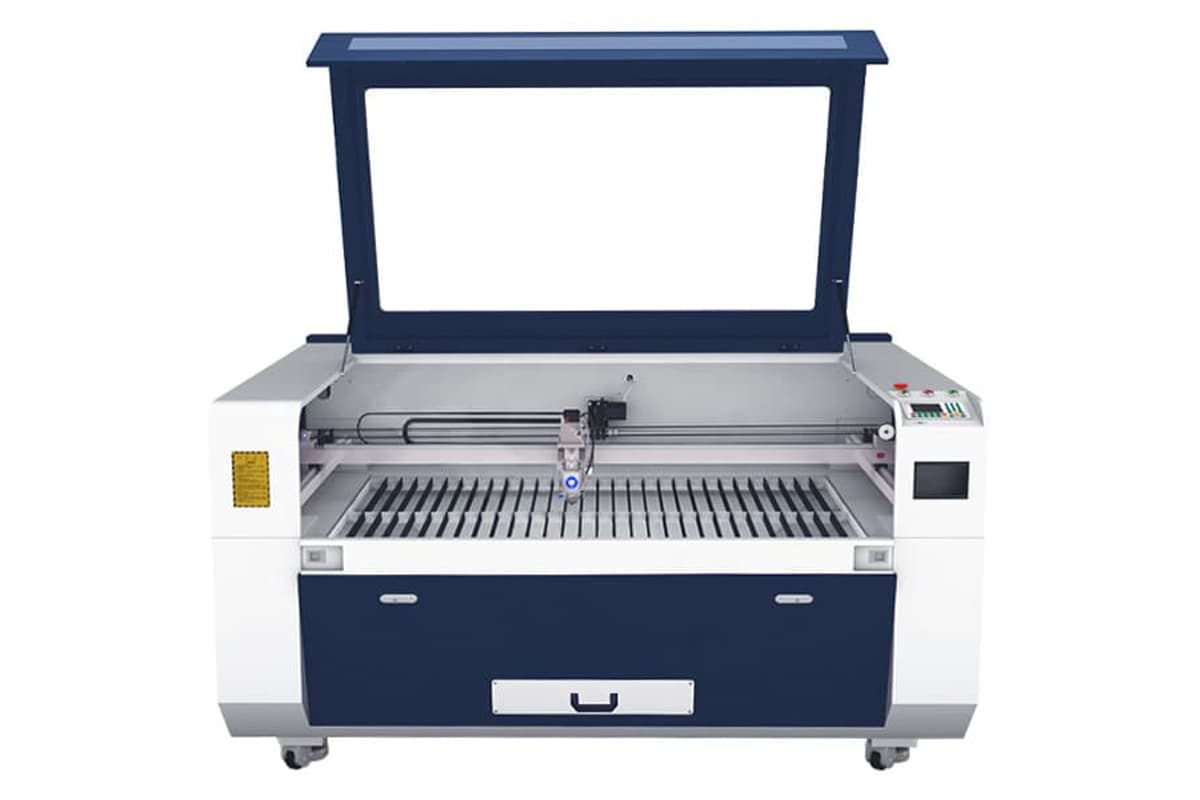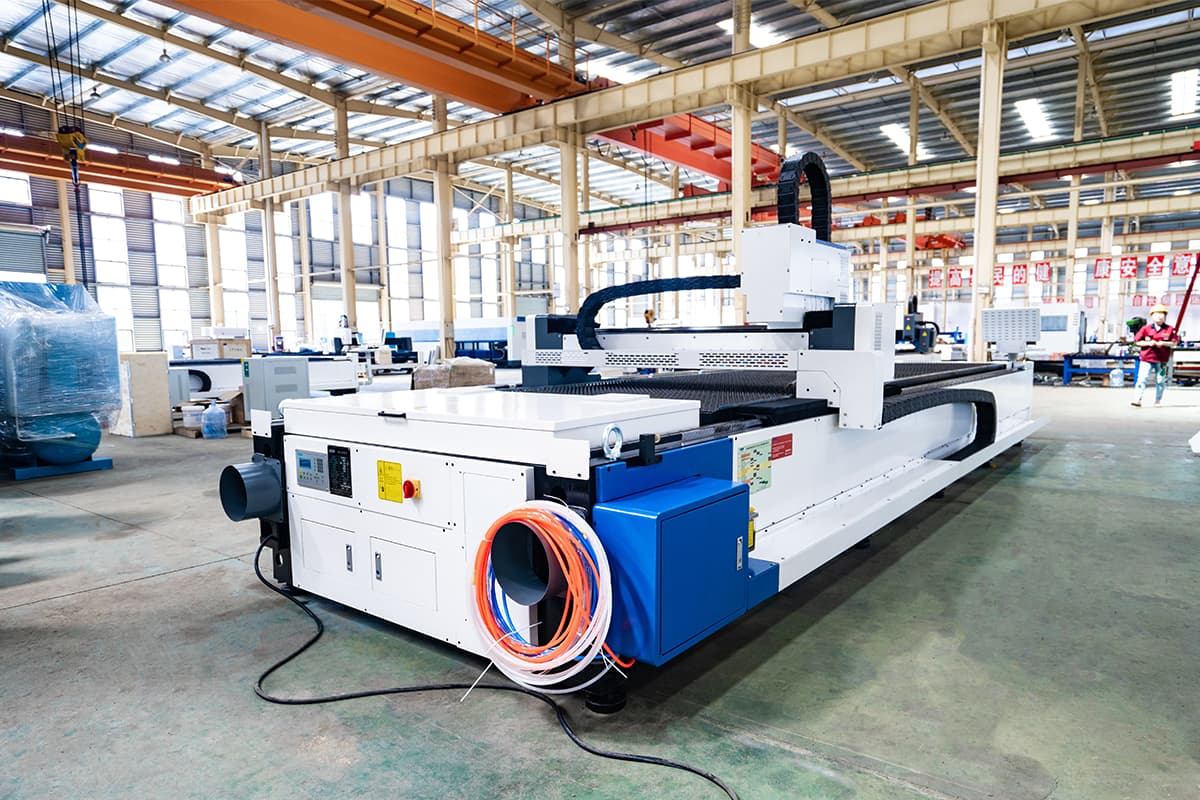The laser cutting machine is an advanced equipment that utilizes laser beams to cut various materials. It’s mainly composed of two parts: a CNC control system and a machine tool. So, how does the laser-cutting machine get the job done? First, an operator needs to input the designed drawing into the CNC system which will deliver instructions calculated into the processing machine tool. Due to the relative movement of the cutting head and the workpiece, lined and narrow cutting silts are formed to finish the cutting. Laser-cutting machines are widely used in metal processing, aerospace, vehicle manufacturing, and other fabrication industries. It can cut materials like carbon steel, stainless steel, aluminium alloy and titanium alloy, wood and acryllics. It can cut, engrave, punch holes, and weld. However, to ensure its performance, daily maintenance is important. By virtue of its advanced processing quality and wide application spheres, the machine emerges as one of the most crucial equipments for morden manufacturing. The selection of laser cutting machines directly decides productivity, product quaity, costs and market competitive forces for a manufacturing enterprise. Therefore, the intelligent selection of laser cutters paves the way for the opportunity to win in market competitions and sustainable development. Thus, metal processing companies and individuals interested in laser cutters should value all kinds of factors including laser powers, materials to be processed, automatization, cost-effectiveness, after-sale services based on personal demand so as to choose the most suitable one. When purchasing laser cutters, some of the key elements as follows should be considered: Suitable laser type and power are crucial. Different materials suit different types: CO2 laser cutters are suitable for non-metal and thin metal plates with power ranging from 10W to 6000W. Fiber laser cutters are suitable for cutting metals by virtue of faster speeds with power ranging from 500W to 8000W. Relatively thin carbon steel and stainless steel can be cut by low-power fiber lasers(100W-2.5kW), while thick materials require more power. Copper, grass, and other highly reflective materials require fiber lasers that are powered by over 6000w. Therefore, the most economical and efficient laser type and power should be selected based on the materials to be processed and their thickness. The size of the cutting table decides the range of processing sizes. The too small size of the table will limit the workpiece sizes, resulting in lower productivity; too large will occupy extra rooms, and higher costs. Therefore, it’s essential to select proper cutting table sizes according to production shapes and sizes. Cutting speed and precision directly influence the productivity and quality of products: The speed of fiber laser cutters exceeds 30m/min, faster than CO2 lasers. High-power and quality laser cutters can reach higher levels. Besides, their positioning accuracy should be controlled within 0.05mm and repeat accuracy within 0.03mm. What’s more, the speed and accuracy should be balanced so that the accuracy will not be reduced as a result of pursuing speed. A laser cutter should be capable of processing various common metals and non-metals. Carbon steel, stainless steel, and aluminum alloy are the most common metals. They should be capable of cutting highly reflective materials, like copper and grass, and hard-to-machine materials, like titanium and nickel. In addition, other non-metal materials should also be taken into account, such as wood, acrylic, and textile. The more compatible the machine is, the higher utilization is the machine. Automation and additional features are beneficial to improve productivity and product quality. Here are some of the advantages I wish to explain to you: First, automation contains functions of automatic focusing, auromatic edge seeking and automatic avoidance, which greatly reduuces the labor inference. Automaric loading and unloading system allows for labor free production. In addition, automatic height adjustment and an anti-collision device can prevent the cutting head from being damaged. Double-platform alternating operation improves cutting efficiency. Thus, it’s important to choose the most valuable functional combination based on actual dimensions. It’s widely believed that brand reputation and customer support matter when choosing products. The reasons are explained as follows: Premium brands ensure equipment quality and stability so we should corporate with manufacturers who boasts profund technology strengths and independent intellectual property rights. What’s more, brands with reputation have comprehensive trainning and necessary after-sale services, including maintenace and fault response. They can also ensure long-term supply for prone-worn workpiece and components. Laser cutters purchasing is a kind of large-scale investment, so the brand reputation and customer support are closely related to the long-term benifits. Based on the descriptions in detail I explained to you, we can safely jump to the conclusion that many factors are equally important for choosing a laser-cutting machine. Therefore, we should consider laser parameters, sizes, speed accuracy, material compatibility, automation, and other factors. Enterprises or individuals should consider production demand and balance various elements so as to choose the most promising machine that delivers opportunities for companies to win first in market competitions. At present, there are three main types of laser cutters worthy of consideration in the market: CO2 laser cutting machines, fiber laser cutting machines, and hybrid laser cutting machines. I believe you are wondering about more. Don’t worry; I will discuss the pros and cons and recommended models in detail so that they can serve as a reference for you when purchasing. CO2 laser cutting machines are among the most widely applied and advanced machines. They utilize laser generators to irradiate high-density power with 10.6μm wavelengths, which are focused onto the surface of the workpiece by focusing lenses. In this way, the surface of the materials melts or evaporates. At last, the melt is blown out by assisting gases, and the cutting procedures are finished. Pros They cut fast with high efficiency. When it comes to compatibility, it allows for multiple non-metal cutting, including wood, acrylic and plastics. As for metals, such as carbon steel and stainless steel within 25mm in thickness, they also perform well. In other aspects, they produce high-quality cuts, vertical cutting surfaces and small heat-affected areas. Cons The machine also has its weaknesses. For example, their light-electricity transformation rate is relatively low, ranging in 10 to15%. The costs of this kind of machine are high. Therefore, large power CO2 laser cutting machines and their supporting facilities are expensive. Besides, the consumables, like lasers and reflective mirrors, need to be changed regularly which leads to high operation and maintenance expenses. CO2 laser cutters are also unsuitable for high-reflective metals like aluminum and copper. Recommended Models TRUMPF: TruLaser 3030/5030 CO2 laser cutting machine imported from Germany with first-class quality. The fiber laser cutting machine is the most developed machine in recent years. It adopts fiber lasers as a light source and transfers laser into the cutting heads through fibers. Then lasers focused on the surface of the materials by focusing lenses will finish the cutting. Compared with CO2 laser cutting machines, fiber cutters enjoy higher light-electricity transformation, better laser beams, and faster cutting speed. Pros Three times the photoelectric conversion efficiency of CO2 laser cutters and fiber cutters exceed 30%, so they are environmentally friendly and energy-saving. With better laser beams, small focused light spots and hsigh accuracy, they are especially suitable for thin plate cutting. They cut fastly and their speeds are twice or more than those of CO2 laser cuttets with the same power. Fiber transmission with simple light paths and maintenance-free quality reduce the operation costs. The sevice life of core components lasts for over 100,000h, which means they are highly reliable. Cons Most of their components depend on imports, so the machine is expensive. They are unsuitable for non-metals, like wood and acrylic. Their cutting edges weaken when cutting materials with a thickness of over 30mm. In addition, they also have difficulties in dealing with highly reflective metals like aluminum and copper. Recommended Models: Hybrid laser cutting machines integrate two kinds of light sources from CO2 laser cutting machines and fiber laser cutting machines. Light sources can be altered flexibly based on requirements. They have the advantages of CO2 laser cutting machines and fiber laser cutters. Therefore, they can cut metals and non-metals and are widely applied. However, due to complicated structures, they cost more. Pros They can cut multiple materials, including metal and non-metals. They allow for the upgradation of cutting parameters for various materials. They suit small batches of productions. Cons They are expensive, costing 1.5 to 2 times that of a single light source cutting machine with equivalent power. With intricate stuctures, they post high requirements on the optical switch control. A relatively high broken rate requires higher maintenance expenses. Recommended Models Generally speaking, CO2 laser cutting machines, fiber laser cutting machines, and hybrid laser cutting machines each have their own pros and cons and suit different sectors. Thus, consumers should take the factors I listed above into account in order to choose the most valuable one. I hope my article can help you. Based on the chart, enterprises and individuals should select machines based on personal production demands, financial strengths and development plans. It’s suggested that entry- and mid-level laser cutters with high-cost performance be chosen at the beginning and high-end laser cutters later after the accumulation of business and finance. At the same time, premium brands are your choices. Brands with reputation guarantee post-sale services and component supply, which can extend products’ lifespan. In this article, I have provided you with a comprehensive guide for purchasing a laser cutting machine. Whether you are an expert or a novice in the field, I hope my article can serve as an inference for you. At the end of the article, I want to give final recommendations. When purchasing, you should consider all kinds of factors, such as the cutting material, laser type, power, accuracy, environmental protection, and cost-effectiveness. Demands should be listed to compare in many aspects. If necessary, you can also ask the professionals for help. Our company, established in 1982, boasts professional experts and operators. We are one of the leading exporters in China. AHD Machine Tool boasts 4 decades of laser cutting machine R&D history and is one of the leading exporters in China. Our products perform well in accuracy, efficiency, flexibility, cost-effectiveness, and quality. It will be an intelligent selection of you. Therefore, our laser cutting machines which guarantee accuracy, efficiency, quality, and cost-effectiveness, are your wise choices. If you are interested in our laser cutters, please view our product page. Welcome to contact us. Download the Infographic With High Resolution Hydraulic Fittings,Hyd Fittings,Hydraulic Adapter Fittings,Hydraulic Adapters HUAIAN YATAI HYDRAULIC MACHINERY CO., LTD , https://www.yataihydraulic.comI. Introduction
II. Factors to Consider When Buying
Laser Type and Power
Cutting Bed Size
Cutting Speed and Precision
Material Compatibility
Automation and Additional Features
Brand Reputation and Customer Support

III. Top Laser Cutting Machines to Consider
CO2 Laser Cutting Machines
Fiber Laser Cutting Machines
Hybrid Laser Cutting Machines

IV. Budgeting and Cost Considerations
Type Entry-Level Laser Cutting Machines Mid-Range Laser Cutting Machines High-End Laser Cutting Machines Costs hundreds of dollars to thousands of dollars tens of thousands of dollars, around 41000 to 110000 dollars Hundreds of thousands of dollars Applicable materials wood, acrylic, paper and other thin materials medium-thickness metal sheet metals such as stainless steel and carbon steel with a thickness of up to 25mm Efficiency low power and speed and limited processing Their speed and accuracy are higher than entry-level laser cutting machines. High cutting efficiency, with speeds reaching 1.5 to 2 times that of mid-range laser cutting machines Features simple facilities, easy operation Richer facilities which can fix different power of laser cutters high-end facilities; imported components with high stability Suitable users beginners and small businesses most small and medium-sized enterprises High-end manufacturing sector Maintenance costs low medium high V. Conclusion

